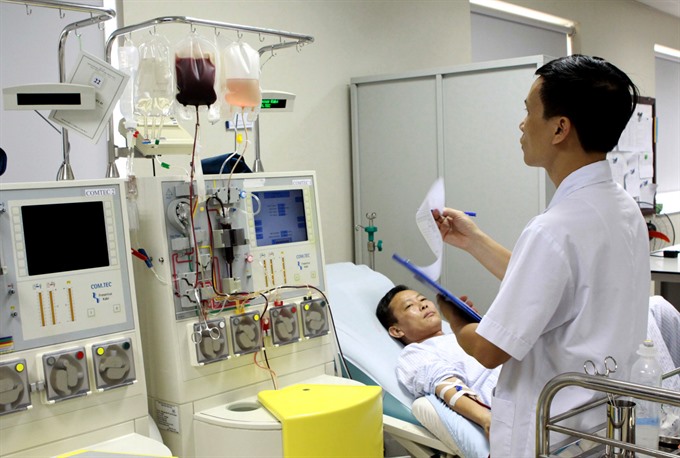 Society
Society

To help patients have stem cell transplants without having to take an expensive trip, the National Institute of Haematology and Blood Transfusion, in collaboration with the National Hospital of Obstetrics and Gynaecology, have been collecting umbilical cord blood samples from pregnant women since May 2014.
 |
| A patient whose stem cells were transplanted at the National Institute of Haematology and Blood Transfusion. — VNA/VNS Photo Dương Ngọc |
HÀ NỘI — Three years ago, Hoàng Thị Thùy Linh, 29, from the central province of Quảng Bình Province, was diagnosed with leukemia (blood cancer). She was told her best chances lay in getting her damaged stem cells replaced.
However, her family could not find any relatives whose tissue type was compatible with hers.
Then a miracle occurred.
Doctors at the National Institute of Haematology and Blood Transfusion (NIHBT) found a compatible stem cell from an unrelated donor in the hospital’s community stem cell bank.
“It was a really big challenge for us. Instead of one and a half to two months, it took three months for the cells to grow in the patient’s body,” Professor Nguyễn Anh Trí, head of NIHBT said.
Linh’s stem cell transplant was the first from the bank. Since 2014, more than ten transplants of stem cells taken from the institute’s umbilical cord blood bank have been conducted.
Doctor Trần Ngọc Quế, director of NIHBT’s stem cell bank, said that in the first years after the technique started to be used in 2006, only one or two genetically-related stem cell transplants were conducted. But since 2011, the institute has been able to handle dozens of cases. The total number of patients saved by the technique has reached nearly 250 so far.
“Stem cell transplants have brought new life to blood disease patients. However, the biggest challenge is not expenses, but donors,” Trí said.
To conduct the transplants, stem cells from donors must match the human leukocyte antigen (HLA) tissue type of the patients.
According to Trí, in Việt Nam, stem cells taken from related donors such as brothers, sisters of patients, accounts for only 30 per cent of transplants. Patients who do not have siblings or those whose siblings do not have compatible tissue types, have to look for unrelated donors. Unrelated donations are not popular in Việt Nam and many patients are forced to go overseas for treatment.
To help patients have stem cell transplants without having to take an expensive trip, NHBT, in collaboration with the National Hospital of Obstetrics and Gynaecology, have been collecting umbilical cord blood samples from pregnant women since May 2014.
So far the institute has collected 3,300 samples, mostly from unrelated donors. The samples are tested, infectious elements are removed and they are ready for transplanting to recipeints with any tissue type.
“Saving stem cells is not new in Việt Nam. Vinmec International Hospital, Institute of Haematology in HCM City, National Paediatrics Hospital have done it. However, they are only stores to save umbilical cord blood samples sent by families.
“The plan of NIHBT is different. We want to set up a stem cell bank by asking pregnant women for samples to make a big store serving the community,” Trí said.
However, the store is still small because the storage process is expensive.
Stem cells taken from newborns’ umbilical cords can be saved for only 15 years. The number of stem cells from one newborn is enough to transplant in children weighing less than 10kg, according to Trí.
“The storing method of the institute saves higher number of stem cells with better quality and can be used on a big scale. The chance of finding compatible stem cells is up to over 97 per cent.
The number of stem cells in the stores is growing. Now we can transplant for patients weighing up to 70kg. It is a very good opportunity for thousands of blood cancer patients,” Trí said.
The research on using stem cells to treat blood disease by a group of 13 NIHBT doctors led by Professor Trí, won the first award in the medical category in the Nhân Tài Đất Việt (Vietnamese Talent Awards) 2016.
Doctor Trần Ngọc Quế said “We plan to maintain the bank with about 4,500 to 5,500 umbilical cord blood samples. Now there are some 200 to 300 blood-related and genetic disease cases that need transplants. The availability of stem cells is valuable for patients with fatal illnesses.
"Stem cells are not only magical medicine for blood-related and genetic diseases, but they also can cure burns, bone-related illnesses, heart failure, nerve system failures, breast cancer, ovary or womb cancer.”
However, transplants don’t come cheap, especially for workers and farmers. Average spending for a stem cell transplant varies from VNĐ200 million to one billion (US$8,900-$44,500), while health insurance covers only 40-60 per cent.
The institute is working with health insurance agencies to offer the most favourable conditions for patients.
“The institute will make efforts to improve the quality of stem cell banks and narrow gaps with the world’s medical sector,” Trí said, adding that the institute will transfer technology to other medical facilities in the country to serve more people. — VNS




